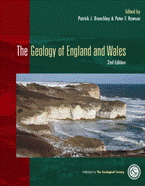The Geology of England and Wales (2nd Edition)

Patrick J Brenchley & Peter F Rawson
Published by: The Geological Society
Publication date: 2006
ISBN: 1-86239-199-8 (hbk); 1-86239-200-5 (pbk)
List price: £85.00 (hbk) & £35.00 (pbk); GSL Member prices: £42.50 & £27.50
559 pp
www.geolsoc.org.uk/bookshop
First published in 1992, this completely revised volume is an altogether higher quality production. The introduction includes two fine colour maps of England and Wales: the modern bedrock geology map and a reduction of William Smith's 1815 map. Incorporating offshore geology, igneous rocks, structure and economic geology into the broadly stratigraphic chapters provides a more coherent account than that of its predecessor.
The Neoproterozoic chapter draws together concisely a lot of disparate information and has some fine palaeogeographic reconstructions and detailed tables.The three chapters detailing the early Palaeozoic history and volcanic rocks are divided so that the Lakesman Terrane, including the Isle of Man, is dealt with separately from the classic stratigraphic sequences of the Welsh basin and adjoining areas. While these chapters include many interesting figures, the Silurian chapter wastes considerable space on poor black-and-white reproductions of amended colour maps from the outstanding 1992 Geological Society Atlas of Palaeogeography and Lithofacies, revised in 1999.
Quite deliberately the discussion of the mid-Devonian deformation phase that formed these Lower Palaeozoic slate belts is left to a chapter about the Acadian Orogeny. This is followed by a short account of the Caledonian intrusive rocks of northern England and the extent of concealed granites beneath eastern England. Then the mainly Devonian alluvial Old Red Sandstones are described before an extensive Carboniferous chapter reflects the wealth of detail that is known about these sediments, including the coal measures. After this, the Variscan Orogeny and resulting structures are discussed at some length before a short chapter on the Cornubian granites and associated mineralization. This is followed by a series of informative and often well-illustrated chapters on the Permian, Triassic, Jurassic, Cretaceous and Paleogene and Neogene sedimentary sequences. These chapters incorporate a lot of offshore evidence accumulated in the search for hydrocarbons.
Far from being an afterthought, the chapter on the Quaternary is a particularly well-written and up-to-date account of this complex and rapidly developing subject, which is bedevilled by the fragmentary nature of these deposits. Unlike many of the other chapters, grid references are widely used to great effect. Furthermore, a clear distinction is made between radiocarbon time and real calendar dates, including only using BP - before present (1950) - after radiocarbon dates, in stark contrast to the Quaternary chapters for Scotland and Spain in this series which have confusing chronologies. A final brief chapter is a brave attempt to outline the future over contrasting time scales, though discussion of climate change in the short term fails to emphasise how rapid is the rate of acceleration in post-industrial atmospheric carbon dioxide levels, even compared to post-glacial events.
The book has a wide ranging index and a fine selection of 36 colour photographs separate from the rest of the text. While such volumes inevitably have a long gestation, it would have been wise to note in the Preface that many of the dates quoted in the text differ from those in A Geologic Time Scale 2004 (Cambridge University Press) – which arrived too late to be assimilated into this volume.
David Nowell
New Barnet, Hertfordshire